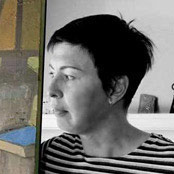Elena Zolotnitsky, The Color of Infinity
The artist Elena Zolotnitsky works within a certain group of themes, genres, and subjects. She is interested in a human being (portrait), in things that surround us (a still-life or interior details), or the world itself (landscape). These three aspects of her artistic vision - a human being per se, our reified memory, and the eternal life of nature - are, in fact, three dimensions of human existence on earth.
Elena Zolotnitsky unfolds themes and realizes content in a very well defined manner. She crops, takes a close-up, dissects the superfluous images of reality. She reconstructs the human face. She can highlight the essential visual motives of a landscape with a stop frame. She can carefully muse on floral still life. Or she can meditate on her favorite interior elements, armchairs, freed from any context. In any alive model, which is a-priori endlessly transforming, she is looking not for its individual pulsating moments which constitute vitality, but for the archetypical ones. Not for the ephemeral aspects, but for the essential everpresent ones. Therefore, the image of an archaic antique bark shines through the face of a completely recognized modern woman, flowers do not have the qualities of a brief bloom, but carry a sign of constancy of form, loaded with the meaning of permanence. On the contrary, static and unchanging in their having-been-made-ness; chairs vibrate, they are full of movement.
Her narrowly defined repertoire, objects of depiction, and principles of artistic representation reveal the artist’s true intentions – to look not around, but into the depth. Indeed, Elena Zolotnitsky’s artistic eye is directed not outward, but into herself; establishing a fine-tuning of the balance between external and internal at the same time. Her constant repetition of the images that form a series allows for one to find endless nuances in the variations on that theme. Zolotnitsky uses a subject form, a day-to-day object, but without an individual appearance, removed from the plots and motives of everyday life and devoid of any reference to specifics of reality. The artist uses different degrees of embodiment. Practically without changing the format of the composition, she either approaches the object, or moves away from it, either achieves clarity of the images, or knocks down the focus of the setting, blurring the contours, sometimes practically dissolving the form in the flow of color or pulsating texture. And in doing so, she guides a viewer’s eye to a nonobjective perception of just a detail and yet… still holding the whole object in its material form. Detachment from excessive objectivity paradoxically makes it possible to comprehend the visible more deeply, since the barriers of imaginary appearances are erased. The visual reality includes a “live abstraction". A uniquely individualized, pliable and fluid idea of plasticity embodied in physical objects and discovered and re-created by an artist.
Elena Zolotnitsky's true reality discloses itself in a variety of emotional states which are conveyed into her rhythmic and tender artistic compositions, primarily, in their colorful and textural transformations. She can lead the same subject through all possible color and tone combinations - warm and cold color sets, triad and chiaroscuro contrasts, vast monocolored planes and delicate yet gradual color shifts. For each painting the artist finds a particular texture for the painting’s surface which is extremely captivating to a viewer's eye, or it can yield its artistic message to the interplay of colors. In Elena Zolotnitsky's art, all drama of emotion, experience and passion - from its conception to its resolution - takes place entirely in the sphere of visual narration. In the streaming of their color and texture, in their visual oscillations. The artist Elena Zolotnitsky has a gift to reveal the eternal in the temporal, in the "inanimate" and static - tremulously alive. And in the given limited format, oddly enough, she visualizes the infinity.
Dr. Galina Tuluzakova
Art historian, a specialist in Nikolai Fechin (1881-1955), a Russian-American painter,
Russian Academy of arts, Honorary Member; Fulbright Fellow 2003
Spain, 2023

